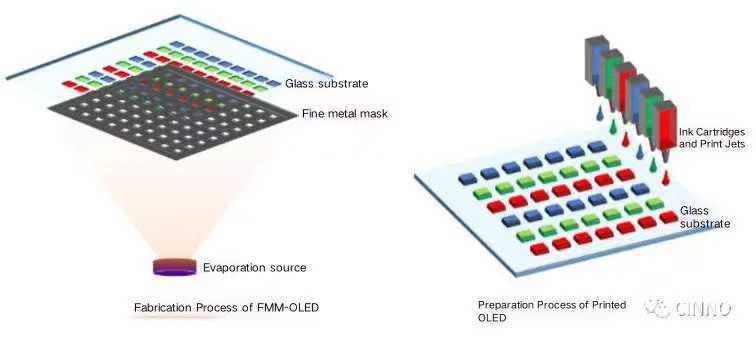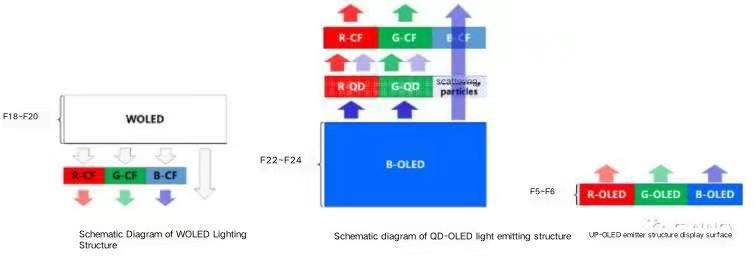The starting gun of printing and display industrialization is officially fired. Recently, reporters understood from the "printing display industrialization and industry chain technology seminar", printing display technology, materials, equipment and other key elements have gradually mature, our country printing display industrialization prologue is about to open. TCL CSOT displayed new printed OLED technologies ranging from 17 inches to 65 inches at the conference site, with various performance advantages over the current mainstream OLED technology. TCL has developed a 274PPI printing display technology that can be used in IT products such as notebooks and tablets. In the future, printed OLED technology has the opportunity to be applied to TV, Monitor, Notebook, Tablet and other products, flexibly realizing production capacity turnover. So what is the advantage and charm of print display, so that many of the world's leading display panel companies set up their trial and research production lines to study it? Today we will take a closer look at its characteristics. The printing display has a simple preparation process and can be applied to products of various sizes. At present, the mainstream technology of small and medium-sized OLED is FMM-OLED technology, which is adopted by Chinese OLED panel enterprises. For domestic companies, there are mainly problems such as foreign patent monopoly, high cost and difficult to break through large size. From a technical point of view, FMM-OLED adopts vacuum evaporation method, which is mainly to heat and sublimate organic materials, and form organic film layers of red, green and blue OLED devices by using high-precision metal mask plates. High precision metal mask plates need to use materials with very low thermal deformation coefficient to make, the size of the holes in the micron level, the positioning accuracy requirements are very high, so the cost is high. At the same time, the effect of gravity will also lead to the deformation of high-precision metal mask plate. Any small deformation will have a significant impact on the alignment and evaporation area, and the larger the size, the more serious the deformation problem, so the application of large generation line is extremely difficult. In contrast to the vacuum evaporation of HFM-OLED, JPP-OLED uses inkjet printing technology to configure organic materials into a solution, and then prints them in a pixel pit on a pre-prepared substrate through a high-precision nozzle that precisely controls the volume of the droplet (skin level, 10-12L) and the location of the inkjet. After vacuum drying, the organic film layer formed by OLED device eventually forms red, green and blue luminous units. OLED technology, printing process is very simple, can be like a "print" to print the screen, don't require expensive vacuum evaporation process at the same time, also need not be expensive and high precision metal mask board, can be applied to all kinds of size range of products (TV/Monitor/Notebook/Tablet).

The structure of printed display products is simple and the cost competitiveness is obvious. In terms of large and medium-sized products, the mainstream OLED technologies in the world are mainly WOLED and QD-OLED. Both WOLED and QD-OLED have very complex device structure and luminous structure. WOLED and QD-OLED also adopt vacuum evaporation method, and use metal mask plate patterning. WOLED is an organic film layer formed on the glass substrate of the whole white OLED device, and then through the patterned anode and color filter to form white, red, green and blue luminous units, in which the white OLED device requires about 18-20 layers of evaporation. The difference between QD-OLED and WOLED is that the organic film layer formed on the lower glass as a whole multilayer OLED device emits blue light, and then on the upper glass substrate, patterned quantum dot light-color conversion layer and whole-surface packaging layer are printed. Finally, patterned color filters are combined to form red, green and blue luminous units. The stacked devices require about 22-24 layers of evaporation.

In contrast, printed OLED only needs to form 5-6 layers of organic film through inkjet printing to form red, green and blue luminous units. The device structure and luminous structure are very simple, and the material utilization rate is as high as 90%, and there is no need for complex technological process and vacuum evaporation equipment. As a result, printed OLED production is expected to be cheaper than both WOLED and QD-OLED in large and medium-size display applications. For example, when producing 65-inch TVS on 10 generation lines, printed OLeds are estimated to reduce BOM costs by 10-20% compared to WOLED and QD-OLED. Meanwhile, the competitiveness of printed OLED extends to the small and medium size display market, where it can reduce BOM costs by about 10 percent compared to the FMM OLED process used in the production of 13.3-inch panels on the 6gen line. In addition, compared with WOLED, QD-OLED, and FMM-OLED, IJP also has lower initial investment costs in equipment and plant construction, and lower operating costs during production.
Gestant Display Technology Co.,Ltd. could provide a series of LCD and OLED products, such as AMOLED Screen, PMOLED Screen, Round Display Screen, Flexible Display Screen, TFT LCD, Mono-LCD and Bar Display Screen. Customize PCBA/LCD/OLED/FPC/Backlight/Coverlens/TP solutions.
Gestant Display Technology Co.,LTD was founded in 2012 in Shenzhen China. Even, the founder of the company, has more than 15 years of rich experience in LCD display industry. He has been engaging in the basic research of LCD display technology in Japan since his graduate school and has been working in the flat panel display industry after graduation.
Proficient in the manufacturing process and technology development of LCD / OLED / polarizer, Even was also one of the members of China liquid crystal Association who has a senior industry background and supply chain resources. In the past three years, he assisted his shareholders in building factories, purchasing equipment,establishing production lines, and successfully obtaining ISO9001 and ISO14001 system certificates.
He has established good business relations with major panel manufacturers in China (BOE /Tianma / IVO /EDO / Visionox), and the glass supply is stable and sufficient.
Gestant Display's products are widely used in Smart wear,Smart home,Outdoor photography,IP phones, Medical care, Industrial control equipment, Automotive and Vehicle displays, Instrumentation, and other Information terminal applications which could offer long-term after-sale services(such as 2 years quality warranty, long-term supply) .
